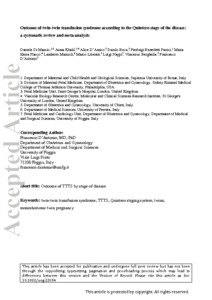Mascio, DD;
Khalil, A;
D'Amico, A;
Buca, D;
Panici, PB;
Flacco, ME;
Manzoli, L;
Liberati, M;
Nappi, L;
Berghella, V;
et al.
Mascio, DD; Khalil, A; D'Amico, A; Buca, D; Panici, PB; Flacco, ME; Manzoli, L; Liberati, M; Nappi, L; Berghella, V; D'Antonio, F
(2020)
Outcome of twin–twin transfusion syndrome according to Quintero stage of disease: systematic review and meta‐analysis.
Ultrasound Obstet Gynecol, 56 (6).
pp. 811-820.
ISSN 1469-0705
https://doi.org/10.1002/uog.22054
SGUL Authors: Khalil, Asma
![[img]](https://openaccess.sgul.ac.uk/111917/1.hassmallThumbnailVersion/uog.22054.pdf)  Preview |
|
PDF
Accepted Version
Available under License ["licenses_description_publisher" not defined].
Download (1MB)
| Preview
|
Abstract
Objectives
To report the outcome of pregnancies complicated by twin–twin transfusion syndrome (TTTS) according to Quintero stage.
Methods
MEDLINE, EMBASE and CINAHL databases were searched for studies reporting the outcome of pregnancies complicated by TTTS stratified according to Quintero stage (I–V). The primary outcome was fetal survival rate according to Quintero stage. Secondary outcomes were gestational age at birth, preterm birth (PTB) before 34, 32 and 28 weeks' gestation and neonatal morbidity. Outcomes are reported according to the different management options (expectant management, laser therapy or amnioreduction) for pregnancies with Stage‐I TTTS. Only cases treated with laser therapy were considered for those with Stages‐II–IV TTTS and only cases managed expectantly were considered for those with Stage‐V TTTS. Random‐effects head‐to‐head meta‐analysis was used to analyze the extracted data.
Results
Twenty‐six studies (2699 twin pregnancies) were included. Overall, 610 (22.6%) pregnancies were diagnosed with Quintero stage‐I TTTS, 692 (25.6%) were Stage II, 1146 (42.5%) were Stage III, 247 (9.2%) were Stage IV and four (0.1%) were Stage V. Survival of at least one twin occurred in 86.9% (95% CI, 84.0–89.7%) (456/552) of pregnancies with Stage‐I, in 85% (95% CI, 79.1–90.1%) (514/590) of those with Stage‐II, in 81.5% (95% CI, 76.6–86.0%) (875/1040) of those with Stage‐III, in 82.8% (95% CI, 73.6–90.4%) (172/205) of those with Stage‐IV and in 54.6% (95% CI, 24.8–82.6%) (5/9) of those with Stage‐V TTTS. The rate of a pregnancy with no survivor was 11.8% (95% CI, 8.4–15.8%) (69/564) in those with Stage‐I, 15.0% (95% CI, 9.9–20.9%) (76/590) in those with Stage‐II, 18.6% (95% CI, 14.2–23.4%) (165/1040) in those with Stage‐III, 17.2% (95% CI, 9.6–26.4%) (33/205) in those with Stage‐IV and in 45.4% (95% CI, 17.4–75.2%) (4/9) in those with Stage‐V TTTS. Gestational age at birth was similar in pregnancies with Stages‐I–III TTTS, and gradually decreased in those with Stages‐IV and ‐V TTTS. Overall, the incidence of PTB and neonatal morbidity increased as the severity of TTTS increased, but data on these two outcomes were limited by the small sample size of the included studies. When stratifying the analysis of pregnancies with Stage‐I TTTS according to the type of intervention, the rate of fetal survival of at least one twin was 84.9% (95% CI, 70.4–95.1%) (94/112) in cases managed expectantly, 86.7% (95% CI, 82.6–90.4%) (249/285) in those undergoing laser therapy and 92.2% (95% CI, 84.2–97.6%) (56/60) in those after amnioreduction, while the rate of double survival was 67.9% (95% CI, 57.0–77.9%) (73/108), 69.7% (95% CI, 61.6–77.1%) (203/285) and 80.8% (95% CI, 62.0–94.2%) (49/60), respectively.
Conclusions
Overall survival in monochorionic diamniotic pregnancies affected by TTTS is higher for earlier Quintero stages (I and II), but fetal survival rates are moderately high even in those with Stage‐III or ‐IV TTTS when treated with laser therapy. Gestational age at birth was similar in pregnancies with Stages‐I–III TTTS, and gradually decreased in those with Stages‐IV and ‐V TTTS treated with laser and expectant management, respectively. In pregnancies affected by Stage‐I TTTS, amnioreduction was associated with slightly higher survival compared with laser therapy and expectant management, although these findings may be confirmed only by future head‐to‐head randomized trials.
| Item Type: |
Article
|
| Additional Information: |
This is the peer reviewed version of the following article: Di Mascio, D., Khalil, A., D'Amico, A., Buca, D., Benedetti Panici, P., Flacco, M.E., Manzoli, L., Liberati, M., Nappi, L., Berghella, V. and D'Antonio, F. (2020), Outcome of twin–twin transfusion syndrome according to Quintero stage of disease: systematic review and meta‐analysis. Ultrasound Obstet Gynecol, 56: 811-820, which has been published in final form at https://doi.org/10.1002/uog.22054. This article may be used for non-commercial purposes in accordance with Wiley Terms and Conditions for Use of Self-Archived Versions. |
| Keywords: |
Quintero staging system, TTTS, monochorionic twin pregnancy, twin-twin transfusion syndrome, twins, 1114 Paediatrics and Reproductive Medicine, Obstetrics & Reproductive Medicine |
| SGUL Research Institute / Research Centre: |
Academic Structure > Molecular and Clinical Sciences Research Institute (MCS) |
| Journal or Publication Title: |
Ultrasound Obstet Gynecol |
| ISSN: |
1469-0705 |
| Language: |
eng |
| Publisher License: |
Publisher's own licence |
| PubMed ID: |
32330342 |
| Dates: |
| Date |
Event |
| 2020-12-01 |
Published |
| 2020-11-12 |
Published Online |
| 2020-04-12 |
Accepted |
|
 |
Go to PubMed abstract |
| URI: |
https://openaccess.sgul.ac.uk/id/eprint/111917 |
| Publisher's version: |
https://doi.org/10.1002/uog.22054 |
Statistics
Item downloaded times since 29 Apr 2020.
Actions (login required)
 |
Edit Item |



